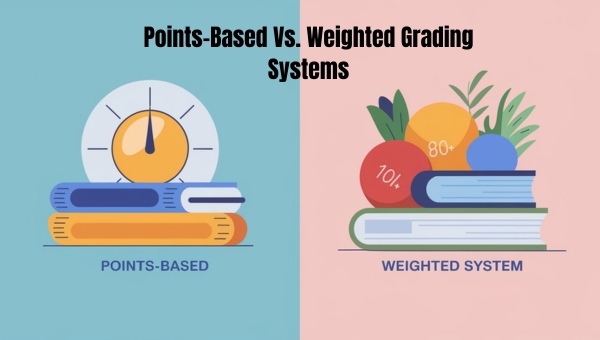How to Calculate Grades: Simplified Guide

Calculating grades can seem challenging, but understanding the process makes it a breeze. In this article, we’ll explore different grading systems and show you how to calculate grades efficiently. We’ll delve into both points-based and weighted grading systems, breaking down each step in simple terms.
You’ll also discover helpful tools to make the process even easier. Ready to unlock the secrets of grade calculation? Let’s dive in to ensure you have all the knowledge you need for accurate and stress-free grade computation.
Understanding Why It’s Important to Calculate Grades
Calculating grades accurately is essential for both students and educators. For students, knowing their grades helps them understand their academic standing and identify areas for improvement.
It provides clear feedback on their progress and achievements. For educators, accurate grade calculation ensures fair and transparent assessment of student performance.

It helps in evaluating the effectiveness of teaching methods and curriculum. Moreover, precise grading is crucial for academic records, affecting opportunities like scholarships and college admissions.
Highlighting any discrepancies early ensures that students get the support they need in a timely manner. Accurate grading is fundamental to maintaining the integrity of the educational process.
Points-Based Vs. Weighted Grading Systems
Understanding the differences between points-based and weighted grading systems is crucial for accurately assessing student performance.
Both systems have unique methods for calculating grades, and knowing how each works can help students and educators make informed decisions about academic evaluations.

Points-Based System
A points-based grading system assigns a specific number of points to each assignment, test, or activity. The total points a student earns are divided by the total possible points to determine the final grade.
- Simple Calculation: Add up all the points a student has earned.
- Total Points: Sum the total possible points for all assignments.
- Final Grade: Divide the earned points by the total points and multiply by 100 to get a percentage.
This system is straightforward and easy to understand, making it a popular choice in many classrooms.
Weighted Grading System
The weighted grading system assigns different percentages or weights to various categories of assignments, such as homework, quizzes, and exams. Each category contributes a different amount to the final grade.
- Assign Weights: Determine the weight of each category (e.g., homework 30%, exams 50%, quizzes 20%).
- Calculate Category Scores: Multiply the student’s score in each category by its weight.
- Sum Weighted Scores: Add up all the weighted scores to get the final grade.
This system ensures that more significant assignments have a greater impact on the final grade, reflecting their importance in the overall assessment.
How To Calculate Points-Based Grades?
Calculating grades using a points-based system is straightforward once you understand the fundamentals. This system allocates a specific number of points to each assignment, test, quiz, or activity.

Here’s a step-by-step guide to help you navigate the process:
- Determine Total Points Possible:
- Start by adding up the total points available for all assignments, tests, quizzes, and activities. For instance, if you have four assignments worth 25 points each, two tests worth 50 points each, and one quiz worth 20 points, your total points possible would be 220.
- Calculate Points Earned:
- Next, add up the points the student has earned. If a student scores 20 on each assignment, 40 on each test, and 15 on the quiz, their total points earned would be 170.
- Divide Points Earned by Points Possible:
- To find the percentage, divide the total points the student earned by the total points possible. Using our example, you would divide 170 (points earned) by 220 (total points possible).
- Multiply by 100 to Get the Percentage:
- To convert the result into a percentage, multiply by 100. So, 170 divided by 220 equals approximately 0.7727. Multiply this by 100 to get 77.27%.
- Assign Letter Grades (if applicable):
- Convert the percentage into a letter grade based on your grading scale. Typically, 90-100% might be an A, 80-89% a B, and so on. In our example, 77.27% might correspond to a C, depending on the grading scale.
By following these steps, you can efficiently calculate points-based grades. This system makes it easy to assess student performance and ensure transparency in grading.
How To Calculate Weighted Grades?
Calculating weighted grades involves several steps to ensure you get an accurate final grade. This method considers the different importance, or weight, of various assignments, tests, and activities.
Here’s a step-by-step guide to help you navigate the process:
- Identify the Weights of Each Component:
- Determine the weight assigned to each component of your coursework. For example, exams might be 50%, quizzes 20%, homework 20%, and class participation 10%.
- Convert Each Component to a Decimal:
- Convert the weights into decimal form. For instance, 50% becomes 0.50, 20% becomes 0.20, and so on. This makes calculations easier.
- Calculate the Average Grade for Each Component:
- If you have multiple grades for quizzes or assignments, find the average grade for each category. For example, if you scored 85, 90, and 95 on quizzes, the average would be (85+90+95)/3 = 90.
- Multiply Each Average by Its Weight:
- Multiply the average grade of each component by its decimal weight. For example, if your average quiz grade is 90 and the weight is 0.20, you calculate 90 * 0.20 = 18.
- Sum All the Weighted Components:
- Add up all the weighted scores. Using the previous example, if your weighted quiz score is 18, your weighted exam score is 45, your weighted homework score is 18, and your weighted participation score is 9, you sum these to get your final grade: 18 + 45 + 18 + 9 = 90.
- Double-Check Your Calculations:
- Ensure all calculations are correct. Double-check each step to avoid errors and ensure accuracy.
By following these steps, you can accurately calculate your weighted grades and understand how different coursework components contribute to your overall performance. Remember, each course might have different weights, so always refer to the syllabus or instructor guidelines for precise information.
Tools For Grade Calculation
Calculating grades manually can be time-consuming and prone to errors. Thankfully, there are several tools available to simplify this process:
- Spreadsheets: Programs like Microsoft Excel or Google Sheets allow you to set up formulas for automatic grade calculations. These tools are versatile and widely accessible.
- Learning Management Systems (LMS): Platforms such as Blackboard or Canvas have built-in grade calculation features. These systems often provide comprehensive grading options and are user-friendly.
- Online Calculators: Websites like GradeCalculator.net offer easy-to-use interfaces for quick grade calculations without needing to set up any formulas.
Using these tools can help ensure accurate and efficient grade calculations.
FAQs
How does a points-based grading system work?
A points-based grading system assigns a specific number of points to each assignment or test. The final grade is calculated by dividing the total points earned by the total points possible.
How to determine my grade with a weighted system?
To determine your grade in a weighted system, multiply the score of each category by its weight, then add the results together. This sum is your final grade.
Are there any tools to help with grade calculation?
Yes, there are several tools available for grade calculation, including online calculators and spreadsheet templates. These tools simplify the process, ensuring accuracy.
Conclusion
Knowing how to calculate grades is crucial for both students and educators. It ensures transparency and helps track academic progress accurately. Whether using a points-based system or a weighted grading system, understanding the methods can make the process straightforward and stress-free.
Each system has its unique benefits and applications, making it vital to choose the one that best fits your needs. With the right tools, calculating grades becomes an easier task. For more informative content on educational tips and tools, make sure to explore other blogs on our site!




